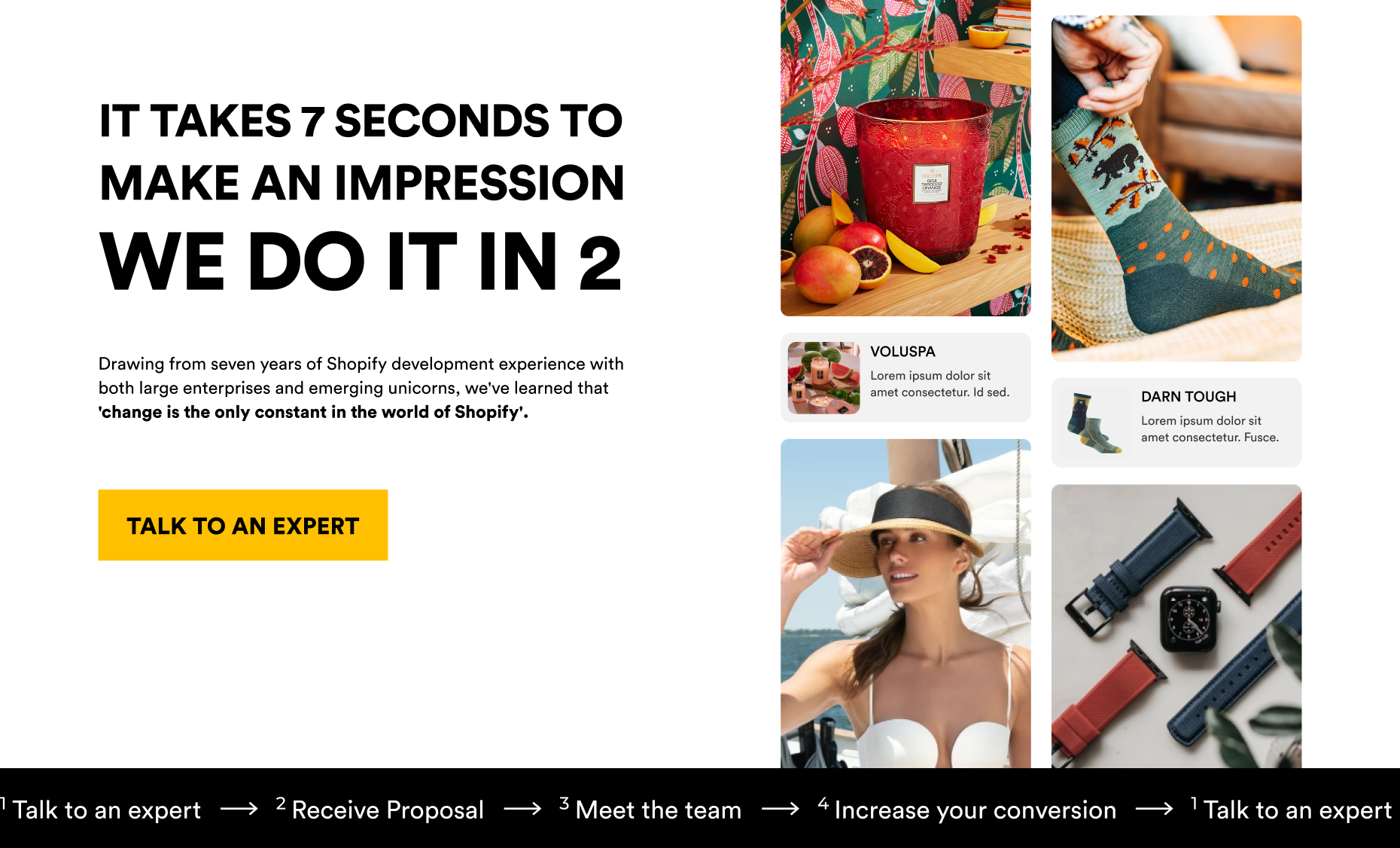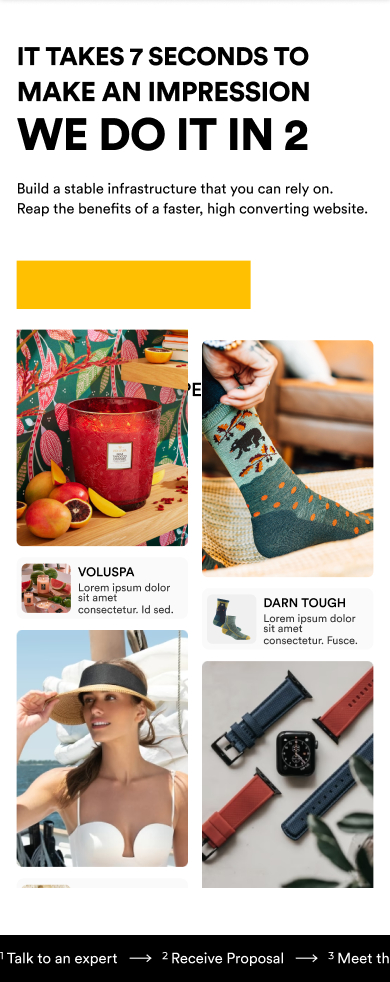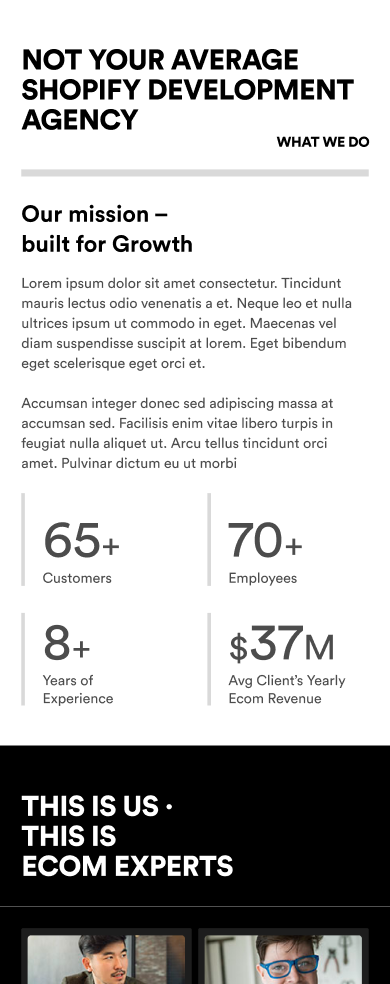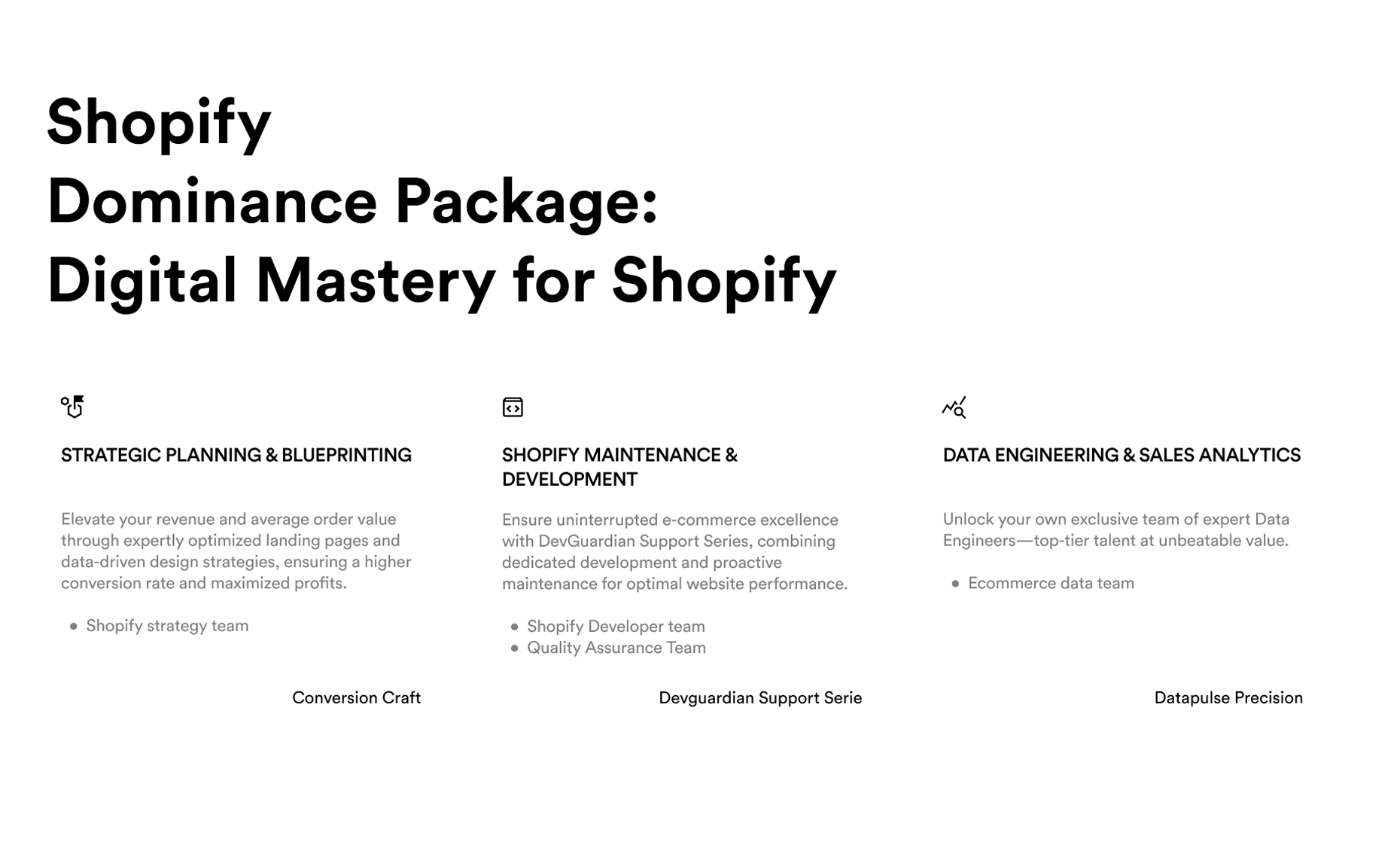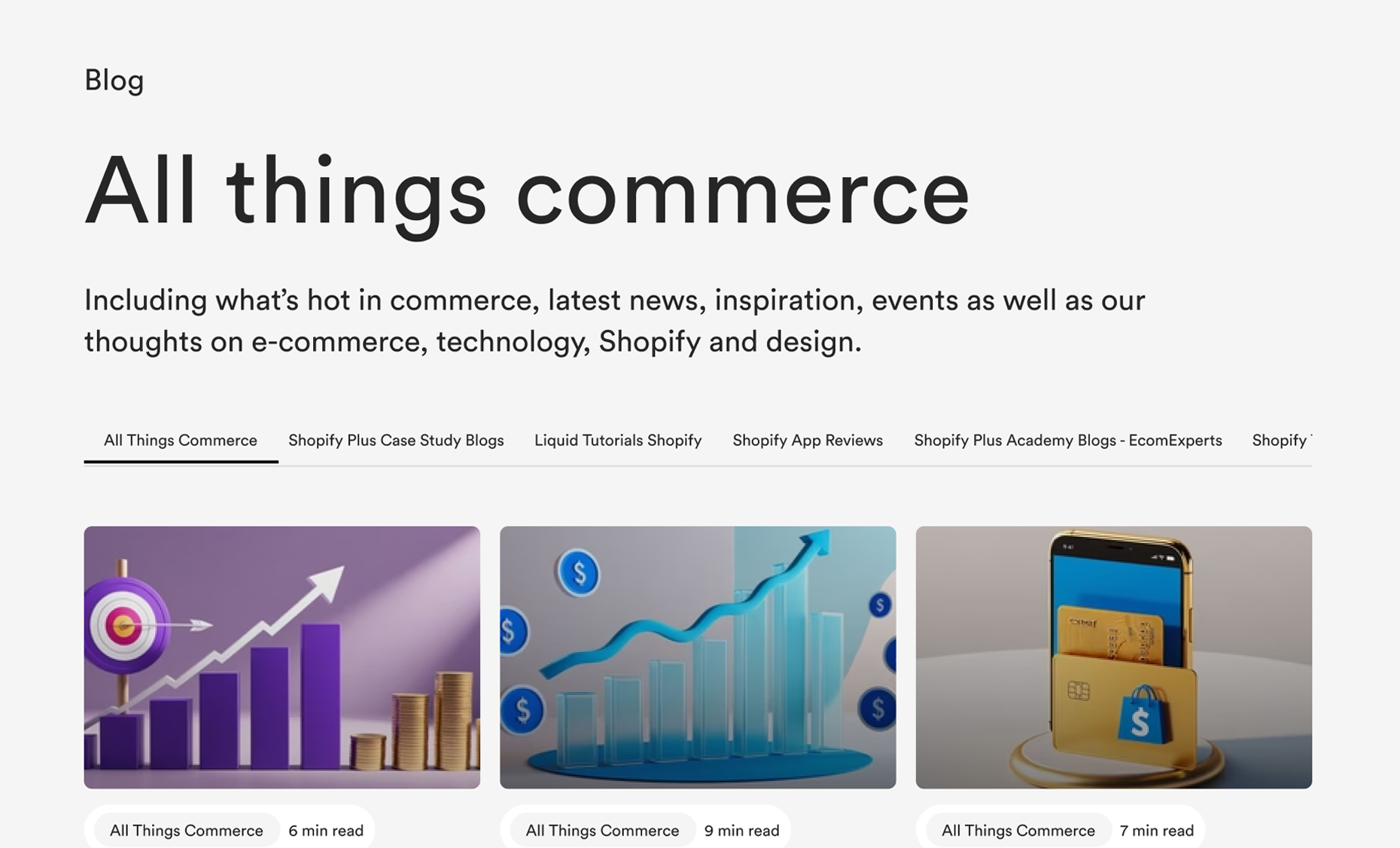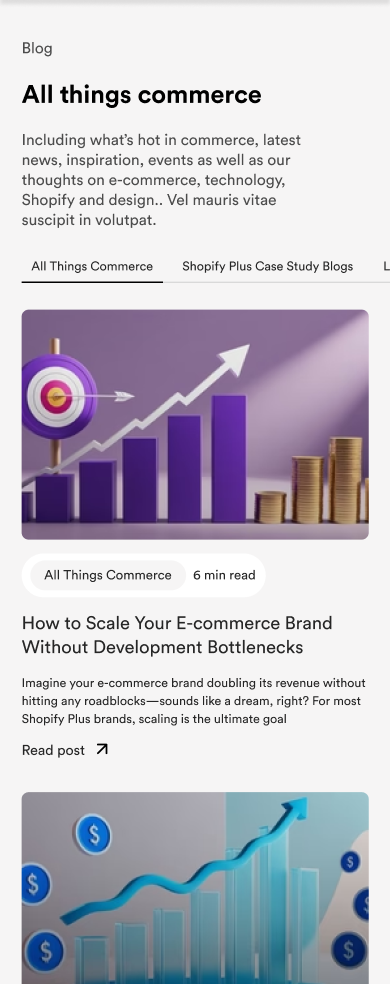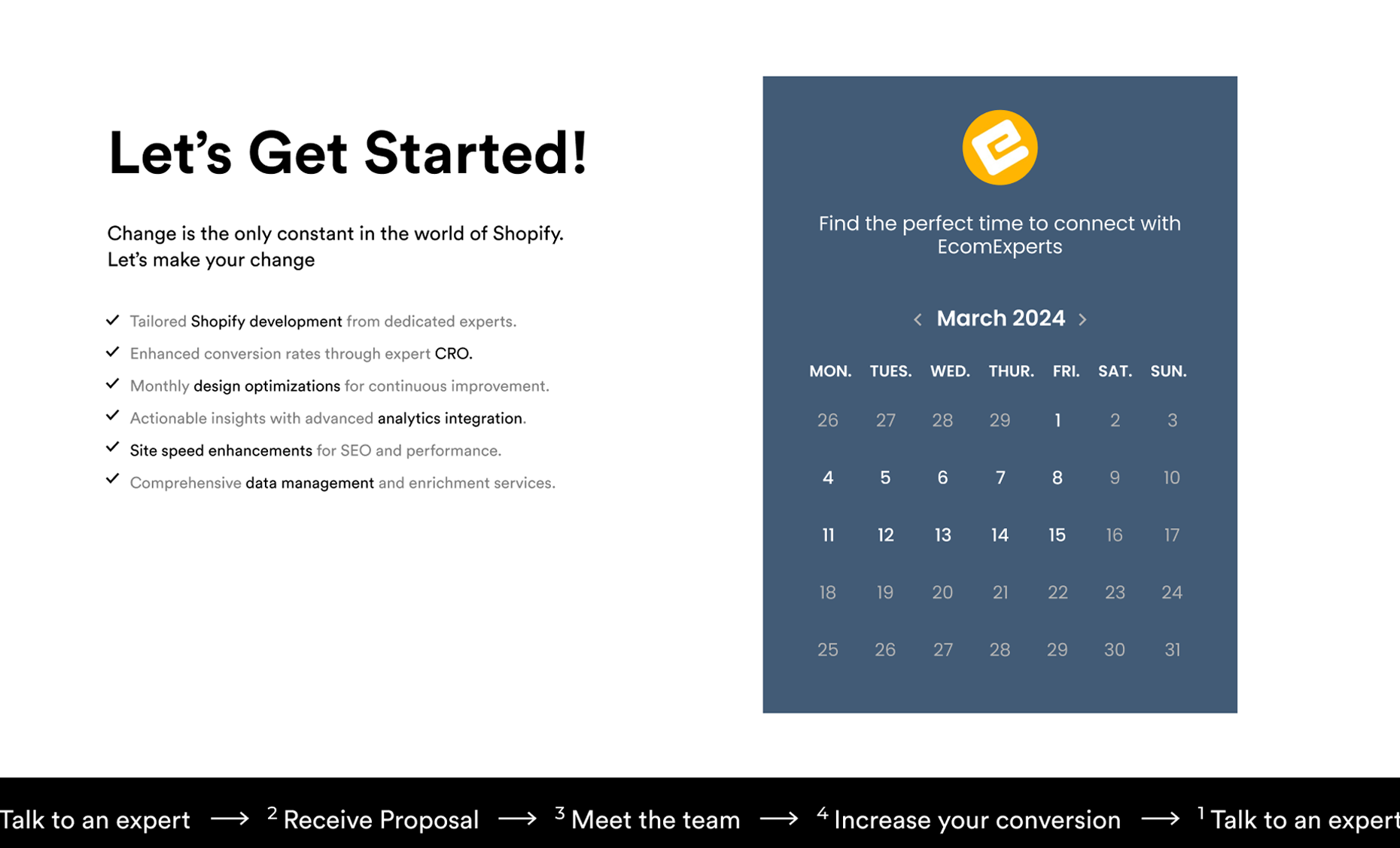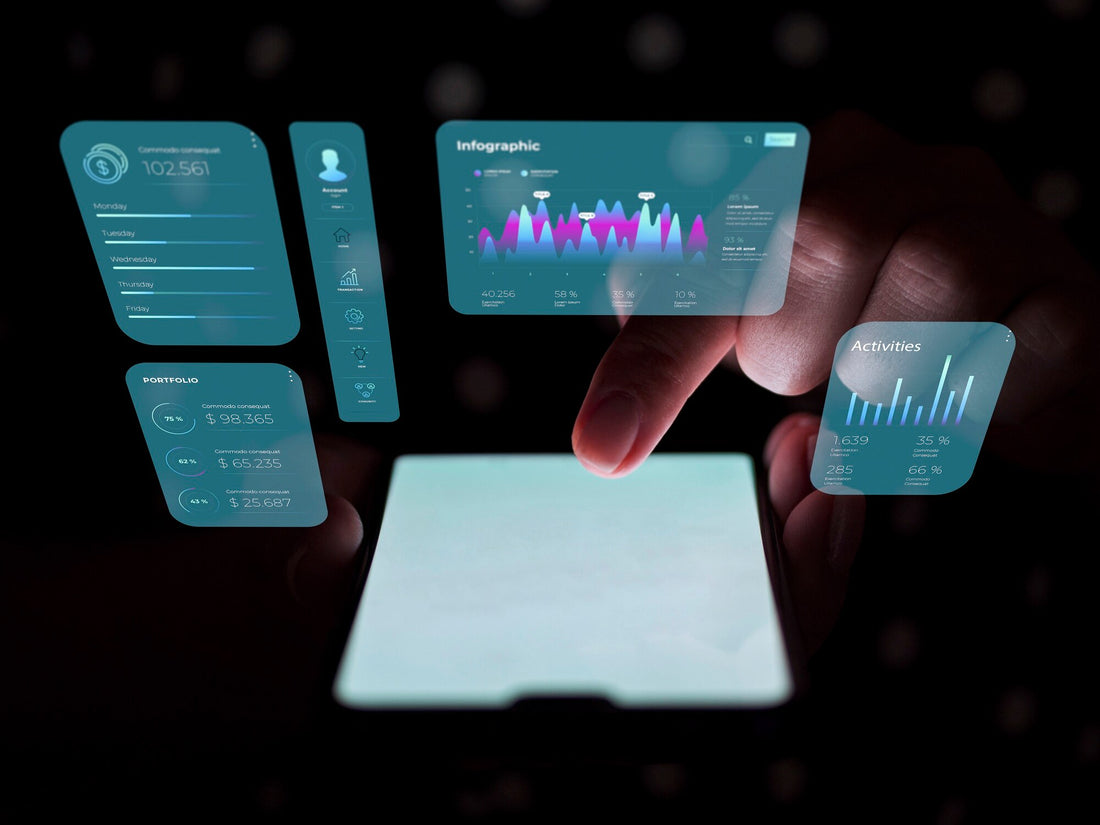If you’re running a Shopify store in 2024, there’s one thing you need to have on lock: Core Web Vitals (CWV).
Google’s laser-focused on these metrics, and they’re not just a passing trend. CWV is shaping up to be the key to dominating search engine rankings, driving conversions, and keeping your customers happy. Whether you’re a Shopify Plus Agency or a solo entrepreneur hustling to scale your e-commerce empire, ignoring CWV isn’t an option.
Now, let’s dive into why this matters and how you can leverage it to give your Shopify store the edge it needs, especially with the holiday season right around the corner.
Overview of Core Web Vitals (CWV)
Definition and Importance in 2024
Core Web Vitals (CWV) is Google’s set of standardized metrics that assess the overall health of your website’s user experience. These metrics are broken down into three key components: Largest Contentful Paint (LCP), First Input Delay (FID), and Cumulative Layout Shift (CLS).
Each of these metrics zeros in on different aspects of your site's performance—how fast it loads, how quickly it responds to user interactions, and how stable it is as it loads.
In 2024, CWV isn’t just a nice-to-have—it’s a must-have. Google’s algorithm now considers these metrics as significant ranking factors, meaning if your Shopify store isn’t up to par, your SEO efforts could take a serious hit.
According to Google, sites that meet the CWV thresholds are 24% less likely to experience high bounce rates, which translates directly into improved user retention and, ultimately, higher conversion rates.
Google’s Emphasis on CWV as Ranking Factors
Google’s mission is to deliver the best possible user experience, and CWV is at the heart of this initiative. Since the algorithm update that rolled out in 2021, Google has placed an increasing emphasis on these metrics, integrating them into the core of its ranking factors.
But why should this matter to you? Because in 2024, if your Shopify store isn’t optimized for CWV, you’re risking a significant drop in organic search rankings.
Think about it: Google’s primary goal is to serve up the best, most user-friendly sites to its users. If your site is slow, unresponsive, or unstable, you’re not just frustrating your visitors—you’re signaling to Google that your site isn’t up to standard.
This could lead to lower rankings, which directly impacts your traffic and, ultimately, your revenue. And with Shopify stocks on the rise, staying ahead of the curve is critical.
Why Shopify Store Owners Should Care About CWV
Impact on User Experience and SEO
Let’s be real—user experience is everything in e-commerce. If your site doesn’t load fast or it’s a pain to navigate, your customers are going to bounce faster than you can say “conversion rate.” CWV plays a crucial role here.
Sites that score well on these metrics not only rank better but also provide a smoother, more enjoyable experience for users. And guess what? Happier users spend more money.
In terms of SEO, the impact is just as significant. With Google’s algorithm now weighing CWV heavily, a poor score can drag your rankings down, even if your content is top-notch. It’s no longer just about keywords and backlinks—site speed optimization and overall performance are key players in the SEO game.
Relevance During High-Traffic Periods Like the Holiday Season
The stakes get even higher during peak traffic periods like Black Friday, Cyber Monday, and the entire holiday season. During these times, your site is going to be under more strain than usual.
If your CWV metrics aren’t optimized, you’re risking slow load times, crashes, and a slew of frustrated customers. And let’s be honest—there’s no faster way to lose a sale than a slow, clunky checkout process.
This is where working with a Shopify Plus Agency like Ecom Experts can be a game-changer. They can help ensure your site is optimized not just for regular traffic but for those high-pressure, high-revenue periods where every second counts. By optimizing your CWV, you’re not just preparing for the holiday season—you’re setting your store up for year-round success.
Understanding Core Web Vitals
Alright, let’s get into the nitty-gritty of Core Web Vitals (CWV). These aren’t just fancy metrics to toss around in meetings—they’re the real deal when it comes to ensuring your Shopify store not only looks good but performs like a well-oiled machine.
In 2024, understanding and optimizing these metrics can make or break your site’s performance and, by extension, your revenue. So, what exactly are these Core Web Vitals, and why should you care? Let’s break it down.
What Are Core Web Vitals?
Core Web Vitals (CWV) are a set of specific factors that Google considers crucial in a webpage's overall user experience. They are part of Google's broader "Page Experience" signal and are composed of three key metrics:
- Largest Contentful Paint (LCP): This metric measures the loading performance of your site. Specifically, it looks at how long it takes for the largest piece of content on the page (like an image or block of text) to become visible within the viewport. Ideally, you want your LCP to occur within 2.5 seconds of when the page first starts loading. A slow LCP can frustrate users, making them more likely to bounce, especially if they're trying to make a purchase on your Shopify store.
- Cumulative Layout Shift (CLS): Ever been on a site where the layout shifts as it loads, causing you to accidentally click on something you didn’t intend to? That’s CLS in action, and it’s a user experience killer. CLS measures the visual stability of your page. If your content shifts around as it loads, it’s a bad look, and it can cost you conversions. A good CLS score is less than 0.1.
- Interaction to Next Paint (INP): This is Google’s upcoming metric that is likely to replace First Input Delay (FID) as a key measurement of a page’s interactivity. INP measures how quickly your site responds to user interactions like clicks, taps, or keypresses. A fast INP (less than 100 milliseconds) means your site feels responsive and user-friendly. While INP isn't yet a part of the official Core Web Vitals, it's crucial to keep an eye on this as Google is expected to incorporate it soon, and it’s already impacting user experience in 2024.
Together, these metrics give you a holistic view of your site’s performance from a user experience standpoint. If your Shopify store nails these, you’re not just keeping Google happy—you’re creating an environment where customers can shop smoothly and confidently, which is the foundation of conversion rate optimization.
The Relationship Between CWV and Overall Website Performance
CWV isn’t just about ticking off some boxes for Google; it’s about real-world impact on how users perceive and interact with your site. Think of CWV as the building blocks of your site’s user experience.
If any one of these metrics is off, the whole structure can come tumbling down. Let’s look at how each of these metrics ties into your overall website performance:
- Loading Speed (LCP): A fast-loading page makes a strong first impression. It’s like opening the doors to your store and having everything ready and in place for your customers. If your Shopify store loads quickly, users are more likely to stay, browse, and buy. A slow LCP, on the other hand, is like keeping your customers waiting at the door—chances are, they’ll just walk away.
- Visual Stability (CLS): Nobody likes a wobbly website. A stable layout that doesn’t shift around as it loads makes for a smoother, more predictable user experience. It’s like walking into a well-organized store where everything is in its place—your customers feel at ease and focused on shopping, not on dealing with annoying glitches.
- Interactivity (INP): Quick responses to user actions are critical. If your site is slow to react to a click or a tap, it can be frustrating for users, leading them to abandon their cart or leave your site altogether. It’s akin to having a checkout counter in your store where the cashier takes too long to process a transaction—people will just leave.
How Core Web Vitals Impact SEO
When it comes to SEO, Core Web Vitals are more than just technical metrics—they’re a game changer. Google’s algorithm updates over the past few years have increasingly emphasized user experience, making CWV a crucial ranking factor. Here’s why that matters:
Google’s Algorithm Updates Focused on User Experience
Google is all about delivering the best possible experience to its users. This means that websites offering a fast, stable, and responsive user experience are going to get rewarded in the search rankings.
With Google’s Page Experience update, CWV became a key component of how websites are ranked. If your site isn’t meeting the CWV thresholds, it could be pushed down in the search results, even if your content is top-tier.
In 2024, this focus on CWV is even more pronounced. Google is continuously refining its algorithms to prioritize sites that deliver a great user experience. So, if you’re still overlooking these metrics, you’re not just missing out on better performance—you’re actively hurting your SEO.
Connection Between CWV, Search Rankings, and Organic Traffic
The connection between CWV and search rankings is clear: better CWV scores lead to better rankings. And better rankings mean more organic traffic. This is especially critical for e-commerce sites, where organic search can be a significant driver of traffic and sales.
But it’s not just about getting people to your site—it’s about keeping them there and converting them into customers. Good CWV scores ensure that once users land on your site, they have a smooth, enjoyable experience that encourages them to stick around, explore, and make a purchase. And with major sales events like Black Friday and Cyber Monday, you can’t afford to have a site that lags or frustrates your visitors.
By optimizing your Shopify store’s CWV, you’re not just improving your Google rankings—you’re setting your site up for long-term success, boosting your conversions, and ensuring that your business remains competitive in a crowded e-commerce landscape.
Benchmarking Your Shopify Store’s Core Web Vitals
So, you’re on board with optimizing your Shopify store’s Core Web Vitals (CWV). But how do you actually measure them?
Benchmarking your store’s CWV is crucial to understanding where you stand and what improvements are needed. Let’s dive into the tools that will help you measure these vital metrics and how to interpret the scores to enhance your store’s performance.
Tools for Measuring Core Web Vitals
To get an accurate read on your Shopify store’s CWV, you need to use the right tools. Here are some of the best ones available:
Google PageSpeed Insights (PSI) is one of the most accessible and user-friendly tools out there for measuring CWV. It provides a comprehensive report on your site’s performance, including detailed metrics on LCP, CLS, and INP. The best part? It gives you both lab data (simulated environment) and field data (real user experiences), so you get a holistic view of how your site performs.
- How it works: Simply enter your Shopify store URL, and PSI will analyze the site, providing a score for each of the CWV metrics. It also offers suggestions for improvement, helping you understand what needs to be fixed.
- Why it’s essential: PSI gives you actionable insights directly from Google, meaning the recommendations are aligned with what will benefit your search rankings the most.
2. Lighthouse, Web Vitals Extension, and Chrome DevTools
While PSI is fantastic for a quick overview, you might want to dig deeper, especially if you're a developer or working closely with one. That’s where tools like Lighthouse, the Web Vitals Chrome extension, and Chrome DevTools come into play.
- Lighthouse: This is an open-source, automated tool built into Chrome DevTools that gives you in-depth reports on your site’s performance, accessibility, SEO, and more. It’s particularly useful for developers looking to optimize specific aspects of their site.
- Web Vitals Extension: This Chrome extension provides a real-time, at-a-glance overview of your site’s CWV as you browse. It’s perfect for spotting issues on the fly and understanding how changes affect your site’s performance in real-time.
- Chrome DevTools: Chrome DevTools is another powerful suite of tools for developers, offering deep insights into your site’s performance. It’s particularly useful for debugging issues related to LCP, CLS, and INP. DevTools allows you to simulate different network conditions and device types, giving you a clear picture of how your site performs across different environments.
Why these tools matter: These tools provide a granular look at your site’s CWV, offering insights that go beyond what PSI can offer. They’re essential for identifying and fixing specific issues that could be dragging down your scores.
Interpreting Your Store’s Core Web Vitals Scores
Alright, you’ve run your store through these tools—now what? Understanding how to interpret your CWV scores is key to making the necessary improvements.
1. How to Read and Understand the Scores for LCP, CLS, and INP
-
Largest Contentful Paint (LCP):
- Ideal Score: Less than 2.5 seconds.
- What it Means: LCP measures how long it takes for the largest visible content (like an image or block of text) to load. If your score is over 2.5 seconds, it’s a sign that your page is loading too slowly, which can frustrate users and lead to higher bounce rates.
-
Cumulative Layout Shift (CLS):
- Ideal Score: Less than 0.1.
- What it Means: CLS quantifies how much your page layout shifts while it’s loading. High CLS scores are usually due to elements loading asynchronously or without predefined space. This leads to a poor user experience, as users might click on something they didn’t intend to.
-
Interaction to Next Paint (INP):
- Ideal Score: Less than 100 milliseconds.
- What it Means: INP measures how quickly your site responds to user interactions, like clicks or taps. A high INP score indicates a laggy, unresponsive site, which can drive users away.
2. Common Issues Found in Shopify Stores
Many Shopify stores struggle with specific issues that can tank their CWV scores. Here are some of the most common problems:
- Large Images and Unoptimized Media: One of the biggest culprits for poor LCP scores is large, unoptimized images. Shopify stores often rely heavily on visuals, but if these aren’t optimized for web use, they can significantly slow down your page load times.
- Third-Party Scripts: Plugins and third-party scripts are another major cause of slow performance. While these tools can add valuable functionality to your store, they can also slow down your site if not properly managed.
- Unstable Layouts: Issues with CLS are often caused by images, ads, or embeds that load without specific dimensions. This causes the content to shift around as the page loads, frustrating users.
- JavaScript Blocking: JavaScript that loads before other crucial page elements can delay interactivity, leading to poor INP scores. This is a common issue on Shopify stores that use multiple plugins or custom scripts.
By regularly measuring and interpreting your CWV scores using the tools mentioned above, you can stay ahead of these issues, ensuring that your Shopify store offers a top-tier user experience.
Optimizing Largest Contentful Paint (LCP)
When it comes to Core Web Vitals, Largest Contentful Paint (LCP) is a critical metric that directly impacts your Shopify store's user experience and SEO. A slow LCP can frustrate users, leading to higher bounce rates and lower conversions. Let’s break down what causes poor LCP in Shopify stores and the actionable steps you can take to improve it.
What Causes Poor LCP in Shopify Stores?
Understanding the root causes of poor LCP is essential for effective optimization. Here are the common culprits:
1. Slow Server Response Times
One of the primary reasons for poor LCP is slow server response times. When your server takes too long to deliver content to the user’s browser, it delays the rendering of the largest visible content, often an image or a large block of text.
- Impact: Slow server response times can significantly delay the first step of the rendering process, making your site feel sluggish and unresponsive.
2. Render-Blocking JavaScript and CSS
Another major factor is render-blocking JavaScript and CSS. These are scripts and stylesheets that the browser must load before it can render the page content. If these resources are too heavy or not optimized, they can prevent the browser from displaying the main content quickly.
- Impact: Render-blocking resources delay the time it takes for the largest content element to appear on the screen, leading to poor LCP scores.
3. Large Image Files
Images are often the largest visible elements on a webpage, and if they aren’t optimized, they can take a long time to load, dragging down your LCP score.
- Impact: Large, unoptimized images can significantly slow down the loading process, making your site feel sluggish, especially on slower connections or mobile devices.
Actionable Steps to Improve LCP
Improving LCP requires a multi-faceted approach, targeting each of the causes mentioned above. Here’s how you can tackle these issues head-on:
1. Optimizing Server Response Times
Importance of Fast Hosting Solutions:
- Choosing a fast and reliable hosting provider is the foundation of a quick server response. Opt for hosting solutions that specialize in speed, particularly those with optimized infrastructure for Shopify stores.
Considerations for Content Delivery Networks (CDNs):
- Why it Matters: A CDN distributes your site’s content across multiple servers worldwide, ensuring that users access your site from the nearest server, reducing load times.
- Action: Implementing a CDN like Cloudflare or Akamai can drastically reduce server response times, particularly for global audiences.
2. Reducing Render-Blocking Resources
Minifying and Compressing CSS and JavaScript:
- Why it Matters: By minifying (removing unnecessary characters) and compressing your CSS and JavaScript files, you reduce their size, allowing the browser to load them more quickly.
- Action: Use tools like Terser for JavaScript and CSSNano for CSS to automatically minify your resources.
Async and Defer Loading for Scripts:
- Why it Matters: By setting scripts to load asynchronously or deferring their load until after the main content has rendered, you can prevent them from blocking the rendering process.
-
Action: Add the
asyncordeferattributes to your script tags in the HTML.
3. Optimizing Images and Media
Using Next-Gen Formats Like WebP:
- Why it Matters: Next-gen formats like WebP are significantly smaller than traditional formats like JPEG or PNG, without compromising quality.
- Action: Convert your images to WebP using tools like ImageMagick or online converters before uploading them to your store.
Lazy Loading Images and Videos:
- Why it Matters: Lazy loading ensures that images and videos are only loaded when they enter the user’s viewport, rather than loading all at once when the page loads.
-
Action: Implement lazy loading with the
loading="lazy"attribute for images and videos in your HTML.
Improving Cumulative Layout Shift (CLS)
Cumulative Layout Shift (CLS) is a Core Web Vital that measures the visual stability of your Shopify store. High CLS scores can be frustrating for users, causing them to lose their place on the page or accidentally click on the wrong element due to unexpected shifts.
This not only impacts user experience but also your store’s SEO and conversion rates. Let’s break down what contributes to high CLS in Shopify stores and the techniques you can implement to minimize it.
What Contributes to High CLS in Shopify Stores?
Understanding the elements that contribute to high CLS is the first step in minimizing layout shifts on your Shopify store. Here are some of the most common factors:
1. Unstable Elements Like Ads, Images, and Third-Party Widgets
- Issue: Ads, images, and third-party widgets that load dynamically without predefined space in the layout can cause the page content to shift as they load. This happens when the browser doesn’t know how much space to allocate for these elements, leading to unexpected layout shifts.
- Impact: When elements load and push content down or around the page, it results in a high CLS score, negatively affecting the user experience.
2. Dynamic Content Loading
- Issue: Dynamic content such as pop-ups, banners, and in-feed ads can cause unexpected shifts if not properly managed. This is common in Shopify stores that rely heavily on third-party apps or scripts that load content after the main page content.
- Impact: Users may experience sudden shifts in content, which can lead to frustration, especially if they were about to interact with a specific element.
Techniques to Minimize CLS
Reducing CLS requires addressing these common issues with targeted strategies. Here’s how you can improve layout stability on your Shopify store:
1. Setting Size Attributes for Images and Videos
Importance of Specifying Width and Height in HTML/CSS:
- Why It Matters: When you specify the width and height for images and videos in your HTML or CSS, the browser reserves the necessary space for these elements before they load. This prevents content from shifting as the media loads.
-
Action: Always define the
widthandheightattributes for your images and videos. If you’re using responsive design, ensure you use aspect ratio boxes to maintain the correct layout on different screen sizes.
Example:
<img src="image.jpg" width="600" height="400" alt="Product Image">
2. Optimizing Font Loading
Use of Font-Display Property to Avoid Layout Shifts:
-
Why It Matters: Fonts can cause layout shifts if they are not handled correctly. When a custom font loads, it can cause the text to resize, leading to a shift in layout. The
font-displayproperty allows you to control how fonts are displayed, ensuring that the layout remains stable. -
Action: Use the
font-display: swap;property to ensure that the text is displayed immediately with a fallback font, and then switches to the custom font once it has fully loaded. This prevents layout shifts and maintains visual stability.
Example:
@font-face { font-family: 'CustomFont'; src: url('customfont.woff2') format('woff2'); font-display: swap; }
3. Managing Third-Party Scripts
How to Reduce the Impact of External Scripts on Layout Stability:
- Why It Matters: Third-party scripts like ads, social media embeds, and tracking codes can introduce unpredictable elements that cause layout shifts. These scripts often load asynchronously and may push content around as they render.
- Action: Use asynchronous loading for third-party scripts whenever possible, and ensure that they do not alter the layout once the main content has loaded. If third-party scripts are necessary, consider reserving space in the layout for their content to load into, or use placeholders.
Example:
- Async Loading:
<script async src="script.js"></script>
- Placeholder Usage: Reserve a space in your layout where the third-party content will load to prevent shifts when it renders.
Enhancing Interaction to Next Paint (INP)
Interaction to Next Paint (INP) is one of the newer metrics that Google is emphasizing, especially as mobile-first design becomes more prevalent. INP measures how quickly a page responds to user interactions—such as clicks, taps, or keyboard inputs—and how soon after these interactions the browser updates the content on the screen.
A slow INP can lead to a frustrating user experience, especially on mobile devices where responsiveness is key. Let’s dive into the common INP challenges in Shopify stores and explore strategies to improve this vital metric.
Common INP Challenges in Shopify Stores
1. Heavy JavaScript Execution
- Issue: One of the primary culprits behind poor INP scores is heavy JavaScript execution. When a user interacts with a page, the browser often needs to run JavaScript code to process the interaction. If the JavaScript tasks are too heavy or poorly optimized, they can cause significant delays in updating the page, leading to a sluggish user experience.
- Impact: Heavy JavaScript not only slows down the interaction but can also cause the page to become unresponsive, particularly on mobile devices with less processing power. This delay in processing user input directly affects the INP score, leading to lower user satisfaction and potentially higher bounce rates.
2. Inefficient Handling of User Input Events
- Issue: Another common challenge is inefficient handling of user input events such as clicks, touches, or keyboard interactions. If these events are not managed efficiently, they can cause delays in rendering the next paint, contributing to a poor INP score.
- Impact: Inefficient event handling can lead to noticeable lag between a user's action and the browser's response. This lag is particularly detrimental on e-commerce platforms like Shopify, where smooth and responsive interactions are crucial for conversions.
Strategies to Improve INP
Improving INP requires a focused approach to optimizing JavaScript execution and enhancing the responsiveness of user interactions. Here’s how you can tackle these issues:
1. Optimizing JavaScript Execution
Identifying and Reducing Heavy JavaScript Tasks:
- Why It Matters: To improve INP, it’s essential to identify the JavaScript tasks that are taking too long to execute. Tools like Chrome DevTools and Lighthouse can help you pinpoint these bottlenecks. Once identified, you can work on optimizing or deferring these tasks to ensure they don’t block the main thread during user interactions.
- Action: Break down large JavaScript tasks into smaller, more manageable chunks. Consider using code-splitting techniques to load only the necessary JavaScript for the user’s current view. This reduces the amount of JavaScript that needs to be executed, thereby improving INP.
Leveraging Web Workers for Off-Main-Thread Processing:
- Why It Matters: Web Workers allow you to run JavaScript in the background, off the main thread. This is particularly useful for heavy computations or long-running scripts that would otherwise block the main thread and delay user interactions.
- Action: Move heavy, non-UI related JavaScript tasks to Web Workers. This keeps the main thread free to respond to user inputs promptly, improving INP and overall site responsiveness.
2. Improving Input Responsiveness
Best Practices for Handling Touch and Click Events:
- Why It Matters: Properly handling user input events is crucial for maintaining a responsive interface. Poorly optimized event listeners or excessive DOM manipulation during input events can lead to delays in updating the interface, negatively impacting INP.
- Action: Use passive event listeners for touch and scroll events to improve performance. Passive listeners don’t block the browser's main thread, allowing it to respond to user inputs more quickly. Additionally, minimize DOM manipulation within event listeners to reduce delays.
Minimizing Input Delay Through Preloading and Efficient Coding Practices:
- Why It Matters: Input delay can also be minimized by preloading critical assets and optimizing the code that runs after an input event. Efficient coding practices, such as debouncing and throttling, can help manage the frequency of certain event handlers, ensuring that the browser isn’t overwhelmed by too many tasks at once.
- Action: Implement preloading strategies for critical assets that are needed immediately after user input. Use techniques like debouncing (delaying the execution of a function to reduce the number of times it’s called) and throttling (limiting the number of times a function is called in a given time period) to optimize event handling.
Leveraging Shopify-Specific Tools and Apps
Shopify is a powerful platform, but to truly unlock its potential and optimize Core Web Vitals (CWV) like CLS, LCP, and INP, leveraging specific tools and apps is crucial.
Whether you’re looking to boost your site speed, improve image loading times, or integrate a Content Delivery Network (CDN), Shopify offers a plethora of apps that can make a significant difference.
In this section, we'll explore the top Shopify apps for optimizing CWV and how to integrate Shopify with CDNs for enhanced performance.
Shopify Apps to Boost Core Web Vitals
Optimizing Core Web Vitals on Shopify isn’t just about manual tweaks; it’s about using the right tools to automate and enhance your site’s performance. Here’s a list of recommended Shopify apps designed to boost your store’s CWV:
1. TinyIMG: Image Optimization
- Purpose: TinyIMG compresses images and optimizes them without compromising quality, which is critical for improving LCP. It also offers lazy loading features, ensuring images are loaded only when they’re about to appear on the user’s screen, reducing the initial load time.
- Why It’s Important: Images are often the largest contentful paint on a webpage, and optimizing them can significantly reduce LCP times.
2. NitroPack: Complete Performance Optimization
- Purpose: NitroPack is an all-in-one optimization tool that handles everything from image compression to caching and minification. It’s a comprehensive solution that directly addresses all three CWV metrics.
- Why It’s Important: NitroPack optimizes various aspects of your site, ensuring that both mobile and desktop versions load quickly and efficiently.
3. Lazy Load by Loox: Lazy Loading for Enhanced Performance
- Purpose: This app specializes in lazy loading images, videos, and iframes, ensuring that only the necessary elements are loaded initially. This reduces the initial load time and improves INP by ensuring that the main thread isn’t bogged down with unnecessary tasks.
- Why It’s Important: By reducing the number of elements loaded upfront, Lazy Load can significantly improve the speed and performance of your Shopify store.
4. Booster Apps: SEO and Speed Optimization
- Purpose: Booster Apps provides a suite of tools designed to improve SEO and site speed. It offers image optimization, script management, and caching features that directly impact CWV.
- Why It’s Important: By combining SEO with speed optimization, Booster Apps ensures that your Shopify store not only ranks well but also provides a fast and seamless user experience.
5. PageSpeed Monitor: Real-Time Performance Tracking
- Purpose: This app monitors your store’s performance in real-time, providing insights into how your site performs in terms of CWV. It alerts you to any issues that arise, allowing you to take quick action.
- Why It’s Important: Continuous monitoring ensures that your optimizations remain effective over time, especially during high-traffic periods like the holiday season.
How to Choose the Right Apps Without Compromising Performance:
Choosing the right apps is critical because while they offer benefits, too many apps can also slow down your site. Here’s how to choose the right ones:
- Prioritize Essential Features: Focus on apps that offer multiple optimization features in one package to reduce the number of apps you need.
- Regularly Audit Your Apps: Periodically review your installed apps to ensure they’re still necessary and that they’re not causing performance issues.
- Test Before Committing: Use A/B testing to measure the impact of each app on your CWV metrics before fully integrating them into your store.
Integrating Shopify with CDNs for Enhanced Performance
Content Delivery Networks (CDNs) are essential for improving site performance, especially for stores with a global customer base. CDNs cache your site’s content across multiple servers worldwide, reducing the time it takes to load your pages by serving them from a server closest to the user.
Overview of Popular CDN Services:
1. Cloudflare
- Overview: Cloudflare is one of the most popular CDNs, known for its robust security features and performance optimization tools. It offers a free tier that is sufficient for many small to medium-sized Shopify stores.
- Benefits: Cloudflare’s CDN services include DDoS protection, global load balancing, and image optimization, which can significantly improve LCP and overall site speed.
2. Fastly
- Overview: Fastly is another leading CDN, known for its edge cloud platform that allows for real-time content delivery and enhanced performance. It’s particularly popular with large-scale e-commerce sites.
- Benefits: Fastly offers advanced features like instant purging and real-time logging, ensuring that your site is always delivering the most up-to-date content quickly.
3. Akamai
- Overview: Akamai is a premium CDN service that offers unparalleled global reach and advanced security features. It’s ideal for large enterprises and stores with high traffic volumes.
- Benefits: Akamai’s intelligent edge platform helps optimize and secure the delivery of your content, ensuring fast load times and high availability, even during peak traffic periods.
Step-by-Step Guide to Integrating a CDN with Shopify:
1. Choose Your CDN Provider:
- Select a CDN that meets your store’s needs. For most Shopify stores, Cloudflare’s free or basic plan is sufficient, but larger stores may benefit from the advanced features of Fastly or Akamai.
2. Configure Your Shopify Store’s DNS Settings:
- After signing up with your chosen CDN provider, you’ll need to update your domain’s DNS settings. This usually involves changing your domain’s nameservers to those provided by the CDN.
3. Set Up Caching and SSL:
- Configure your CDN to cache your site’s static content, such as images, CSS, and JavaScript files. Ensure that SSL is enabled to maintain secure connections between your store and your customers.
4. Test Your Configuration:
- Use tools like GTmetrix or Google PageSpeed Insights to test your site after configuring the CDN. Look for improvements in your CWV metrics, particularly in LCP and INP.
5. Monitor Performance:
- Regularly monitor your site’s performance to ensure that the CDN is functioning correctly. Most CDNs offer analytics tools that provide insights into how your content is being delivered and where potential issues may arise.
By integrating a CDN with your Shopify store, you can significantly enhance your site’s performance, reduce load times, and improve your Core Web Vitals. This is particularly crucial during high-traffic periods like the holiday season, where even minor delays can lead to lost sales.
Conclusion
Leveraging Shopify-specific tools and apps, along with integrating a CDN, can drastically improve your store's Core Web Vitals. Whether you're tackling LCP, CLS, or INP, these strategies offer actionable ways to enhance your store's performance and provide a seamless experience for your customers.
And remember, if you need expert guidance to navigate these optimizations, Ecom Experts is here to help you every step of the way.
Continuous Monitoring and Maintenance
When it comes to maintaining your Shopify store’s performance, particularly its Core Web Vitals (CWV), the work doesn’t end after initial optimizations. Continuous monitoring and maintenance are key to ensuring that your store not only meets Google’s standards but also provides a seamless user experience year-round.
This section delves into why regular CWV audits are essential, how to set up automated monitoring, and the importance of staying updated with Google’s algorithm changes.
The Importance of Regular CWV Audits
Google’s Core Web Vitals are a set of specific factors that Google considers crucial in a webpage’s overall user experience. These metrics are dynamic, meaning they can fluctuate due to changes in your website’s content, structure, or even external factors like server performance.
Regular audits are crucial to ensure that your store continues to meet Google’s CWV benchmarks and maintain strong SEO performance.
Why Regular Audits Matter:
- Fluctuating Performance: Website performance can degrade over time due to updates, added features, or even increased traffic. Regular CWV audits help you catch these issues early.
- SEO Impact: Since Google uses CWV as ranking signals, failing to meet their standards can lead to a drop in search rankings. Regular audits ensure you’re staying competitive.
- User Experience: Ultimately, CWV is about delivering a good user experience. Regular audits help ensure that your customers have a seamless and enjoyable shopping experience, reducing bounce rates and improving conversions.
Setting Up Automated Monitoring:
To make this process less labor-intensive, you can set up automated monitoring for your store’s CWV using tools like Google Search Console and Lighthouse CI.
- Google Search Console: This is your go-to tool for monitoring your site’s overall health, including CWV. Google Search Console provides insights into your site’s performance on the web, alerts you to issues, and helps you understand how Google perceives your store.
- Lighthouse CI: Lighthouse CI is a powerful tool that automates the running of Lighthouse audits, providing ongoing performance checks. It’s particularly useful for catching issues early, as it can be integrated into your CI/CD pipeline.
How Often to Audit and What to Look For:
- Frequency: Ideally, you should perform a comprehensive CWV audit at least once a quarter, with smaller, automated checks running weekly or monthly.
- Key Metrics: Focus on LCP, CLS, and INP. Look for any significant deviations from the benchmarks, such as an LCP above 2.5 seconds, CLS above 0.1, or INP delays.
- Common Issues: Keep an eye out for new render-blocking resources, unoptimized images, and third-party scripts that could be impacting your CWV.
Staying Updated with Google’s Algorithm Changes
Google’s algorithm is constantly evolving, with updates often focused on improving user experience—making it crucial for Shopify store owners to stay informed. A sudden algorithm update can impact your CWV and, consequently, your SEO performance.
Why Staying Updated is Crucial:
- Algorithm Changes: Google updates can impact how CWV are weighted or introduce new metrics that become important. Staying ahead of these changes ensures that your store is always optimized.
- Industry Shifts: As the e-commerce landscape evolves, so too do best practices for web performance. Keeping up with these changes allows you to stay competitive.
Resources for Staying Informed:
- Google Webmaster Blog: Google’s official blog is the best source for updates on algorithm changes, new features in tools like Google Search Console, and other crucial information for webmasters.
- SEO News Sites: Regularly check trusted SEO news sites like Search Engine Journal, Moz, or SEMrush for insights and analyses on the latest Google updates.
- Ecom Experts Blog: As part of your ongoing strategy, regularly review expert blogs, including those from Ecom Experts, for the latest tips, strategies, and case studies related to CWV and Shopify store optimization.
By integrating continuous monitoring and staying informed, you can ensure that your Shopify store remains at the top of its game, providing excellent user experience and maintaining strong SEO rankings.
Regular audits, coupled with staying ahead of Google’s updates, position your store not just to keep up with the competition but to lead the way.
Preparing for the Holiday Season
The holiday season, particularly Black Friday, Cyber Monday, and the days leading up to Christmas, is the most critical time for any e-commerce business. For Shopify store owners, this period can make or break your year.
With the surge in traffic, optimizing Core Web Vitals (CWV) becomes not just important but essential. Here’s why you need to get this right and a final checklist to ensure your store is ready for the peak shopping season.
Why Optimizing Core Web Vitals Is Critical During High-Traffic Periods
When holiday shopping kicks into high gear, your Shopify store will likely experience a significant spike in traffic. While this is great for potential sales, it can also strain your website’s performance, leading to slower load times, layout shifts, and poor interaction times—all of which are measured by CWV. Here's why optimizing these metrics is crucial during high-traffic periods:
- Impact on User Experience: During high-traffic periods, even slight delays or disruptions can lead to a frustrating shopping experience. According to Google, as page load time goes from 1 second to 10 seconds, the probability of a mobile site visitor bouncing increases by 123%. A well-optimized site ensures that users can browse and checkout without any hitches, regardless of traffic volume .
- SEO and Organic Traffic: Google’s algorithm heavily factors in CWV, especially during times when users are making quick, comparative decisions. Sites that perform poorly can see a drop in rankings right when visibility is most crucial .
- Conversion Rates: Studies have shown that a one-second delay in page load time can result in a 7% reduction in conversions. During high-stakes periods like Black Friday, every second counts. Optimizing CWV can significantly reduce cart abandonment and increase your conversion rates during the holiday rush .
Preparing Your Shopify Store for Black Friday, Cyber Monday, and the Holiday Rush
With the stakes so high, here’s how you can prepare your Shopify store to handle the increased traffic during peak shopping days:
-
Stress Test Your Site:
- Use tools like Google’s Lighthouse or GTmetrix to simulate high traffic and see how your site performs under pressure. Identify bottlenecks that could slow down your site during peak times.
-
Optimize for Mobile:
- Mobile shopping is expected to account for a significant portion of holiday sales in 2024. Ensure your mobile site is optimized for speed, with fast-loading pages and smooth navigation.
-
Ensure Fast Server Response Times:
- Consider upgrading your hosting plan or using a Content Delivery Network (CDN) like Cloudflare to reduce latency and server load. This will help maintain fast server response times even during traffic surges.
-
Minimize Render-Blocking Resources:
- Reduce the impact of heavy JavaScript and CSS by minifying and deferring non-essential scripts. This will help improve LCP and ensure that critical content loads quickly.
-
Prioritize Key Content:
- Ensure that your most important content, like product images and CTAs, loads first. Lazy load less critical elements to improve the initial load time.
-
Optimize Checkout Process:
- Streamline your checkout process by reducing the number of steps and optimizing payment options. A fast, simple checkout can drastically reduce cart abandonment during the holiday rush.
-
Regular Monitoring and Updates:
- Keep a close eye on your site’s performance metrics using Google Search Console and other monitoring tools. Be ready to make quick adjustments if you notice any dips in performance.
Final Checklist for Peak Season Optimization
As the holiday season approaches, it’s crucial to ensure that your Shopify store is not only optimized for regular traffic but also fully prepared to handle the surge of visitors that comes with Black Friday, Cyber Monday, and the holiday shopping frenzy. Here’s a quick summary of all the key steps covered in the blog:
- Review and Optimize CWV: Make sure your Largest Contentful Paint (LCP), Cumulative Layout Shift (CLS), and Interaction to Next Paint (INP) scores are within Google’s recommended ranges.
- Conduct a Performance Audit: Use tools like Google PageSpeed Insights, Lighthouse, and Chrome DevTools to identify and fix any performance issues.
- Stress Test Your Site: Simulate high-traffic scenarios to ensure your site can handle the load without crashing or slowing down.
- Enhance Server and CDN Capabilities: Upgrade your hosting and integrate with a CDN to maintain fast server response times during peak periods.
- Optimize Images and Media: Compress and convert images to next-gen formats like WebP, and implement lazy loading to improve page load times.
- Streamline Checkout Process: Simplify and optimize your checkout process to reduce cart abandonment during the holiday season.
- Set Up Continuous Monitoring: Implement automated monitoring using Google Search Console and Lighthouse CI to keep track of your site’s performance in real-time.
- Stay Updated with Google’s Algorithm: Regularly check Google Webmaster Blog and other SEO news sites for any updates that could affect your CWV and SEO.
With these steps in place, your Shopify store will be fully optimized and ready to handle the holiday rush, ensuring that you maximize your conversions and keep your customers happy during the most critical shopping season of the year.
Conclusion
As we wrap up this comprehensive guide, it’s clear that optimizing Core Web Vitals (CWV) is not just a technical necessity but a strategic imperative for any Shopify store aiming to thrive in today’s competitive e-commerce landscape.
From improving user experience to boosting SEO rankings, CWV plays a crucial role in driving traffic, reducing bounce rates, and increasing conversions, especially during high-traffic periods like the holiday season.
Recap of Key Takeaways:
- Core Web Vitals Are Essential: They directly impact your site's performance, user experience, and search engine rankings. LCP, CLS, and INP are the three critical metrics to focus on.
- Continuous Monitoring Is Key: Regular audits and real-time monitoring are necessary to maintain optimal performance, especially during peak seasons.
- Strategic Optimization Drives Results: From leveraging CDNs to optimizing images, every step counts towards improving your CWV scores and ensuring a seamless shopping experience for your customers.
Partner with Ecom Experts
Don’t leave your store’s performance to chance. Whether it’s fine-tuning your checkout process, enhancing site speed, or ensuring that your store is fully prepared for the holiday rush, Ecom Experts has the tools and experience to help you succeed.
Let us guide you through the process, ensuring that your Shopify store not only meets but exceeds the expectations of both Google’s algorithms and your customers.
FAQs
Q1. What are Core Web Vitals and why do they matter for Shopify stores?
A1. Core Web Vitals (CWV) are a set of specific metrics defined by Google to measure user experience on a website. They include Largest Contentful Paint (LCP), Cumulative Layout Shift (CLS), and Interaction to Next Paint (INP). For Shopify stores, optimizing CWV is crucial because these metrics directly impact user experience, site performance, and SEO rankings.
A well-optimized Shopify store not only ranks better in search results but also provides a smoother shopping experience, which can lead to higher conversion rates and customer retention.
Q2. How can I check my Shopify store’s Core Web Vitals?
A2. You can check your Shopify store’s Core Web Vitals using tools like Google PageSpeed Insights, Lighthouse, or Chrome DevTools.
These tools provide detailed reports on LCP, CLS, and INP, allowing you to identify areas that need improvement. Google Search Console also offers insights into your store’s CWV performance and alerts you to any issues that could affect your rankings.
Q3. What are the best practices for optimizing LCP on Shopify?
A3. Optimizing LCP (Largest Contentful Paint) involves several best practices:
- Improve server response times by using a fast hosting provider or a Content Delivery Network (CDN).
- Reduce render-blocking resources by minifying CSS and JavaScript files and deferring non-critical scripts.
- Optimize images by using next-gen formats like WebP and implementing lazy loading to ensure faster loading times for large media files.
Q4. How can I reduce Cumulative Layout Shift (CLS) in my Shopify store?
A4. To reduce CLS (Cumulative Layout Shift) in your Shopify store:
- Set explicit size attributes (width and height) for images and videos in your HTML/CSS to prevent layout shifts during loading.
-
Optimize font loading by using the
font-displayproperty to ensure that fonts load without causing shifts. - Manage third-party scripts carefully, as these can often cause unexpected layout changes. Ensure that any external widgets or ads are stable and do not interfere with the layout.
Q5. What are the most effective ways to improve Interaction to Next Paint (INP)?
A5. Improving INP (Interaction to Next Paint) focuses on reducing delays between user interactions and the browser’s response:
- Optimize JavaScript execution by reducing the size of heavy scripts and offloading non-critical tasks to Web Workers.
- Improve input responsiveness by using best practices for handling touch and click events, such as preloading critical resources and minimizing input delay through efficient coding.
Q6. Which Shopify apps are best for optimizing Core Web Vitals?
A6. Several Shopify apps can help optimize Core Web Vitals, including:
- TinyIMG for image compression and optimization.
- Page Speed Optimizer for reducing load times and improving LCP.
- LazyLoad by LazySizes for implementing lazy loading across your site, which can improve LCP and CLS.
Q7. How often should I monitor my Shopify store’s Core Web Vitals?
A7. Regular monitoring of your Shopify store’s Core Web Vitals is crucial. It’s recommended to audit your site’s CWV at least once a month using tools like Lighthouse CI or Google Search Console.
Additionally, conducting more frequent checks during high-traffic periods, such as the holiday season, ensures that your site remains optimized as traffic surges.


